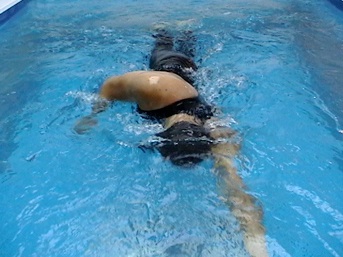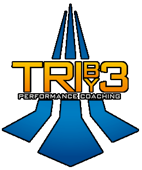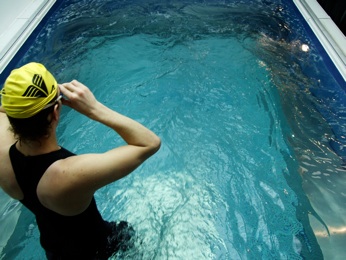Swimming Philosophy

My work in marketing with TGI Healthworks, Inc (www.tgiheatlthworks.com) in the United States has helped me to understand aspects of selling, motivational speaking, organizing events and travel, keeping records, being in charge of groups and projects, and the importance of taking initiative and leadership. My responsibilities as program manager for TGI Healthworks, include teaching people with chronic diseases how to swim for fitness and enjoyment in order to improve their quality of life despite their chronic conditions. As the TGI senior coach, I was able to build the competitive and fitness coaching division.
My desire to build my own successful swim coaching company (sbillswimming) within TGI, and later a triathlon coaching company (TriBy3, Ltd), has helped me to work with athletes of all levels and ages. It has allowed me to study the human body in relationship to the water and to work with world champions, young children, recreational swimmers, and beginner triathletes as well as phobic swimmers. These experiences have helped me discover the most effective and efficient way of communicating my philosophy to anyone who wants to learn the sport.
During my Swiss German education I was on a small swim team in Switzerland where I swam with future Olympians and several Swiss national champions. It allowed me to travel throughout the Europe and participate at swim meets and swim camps in Switzerland, Germany, Austria, Spain, Hungary, the Netherlands and France. Even though, I was never one of the top swimmers at a young age, I was still nationally ranked and traveled and attend international competitions.
During my studies as an architect, I coached and taught the youth program of my former swim team. While the team was only able to practice three times a week for 90 minutes we nevertheless produced several youth national medalists and champions. All of my swimmers were ranked in the top ten in at least one stroke in their age group and one of them (Lukas Salvisberg) is now an ITU Triathlon World Champion. Given the limited amount of practice, such results were unheard of. During that time I was fortunate enough to get invited to work very closely with Marco Pilloud, founder of Total Immersion (TI) Europe GmbH.
Total Immersion (http://www.totalimmersion.net) is the premiere aquatic teaching organization in the world. The organization teaches and coaches swimmers of all abilities, including elite swimmers, as well as those swimming for fitness and rehabilitation. Total Immersion uses a highly evolved coaching program employing unique techniques. Terry Laughlin, founder and CEO of Total Immersion in the U.S., and my swim coach mentor since 2005, explains how Total Immersion compares to traditional swim instructions:
“Traditional instruction focuses on pulling, kicking and endless laps. Total Immersion teaches swimmers to swim with the effortless grace of fish by becoming one with the water. Total Immersion emphasizes the same patient precision and refinement taught by martial arts masters. Total Immersion starts with simple skills and movements and progresses by small, easily mastered steps. The Total Immersion students thrive on the attention to detail and the logical sequence of progressive skills.”

The progressive skills Terry Laughlin mentions are:
•Mastering balance
•Reducing drag
•Swimming with your core
•Lengthening your stroke and maximizing each single motion forward
Through Swiss Swimming, I was also able to take courses and clinics with some of the sport’s best coaches such as Gennadi Turetsky (coach of Alexander Popov, four-time Olympic Gold Medalist), Joseph Nagy (coach of Mike Barrowman, Olympic gold medalist) as well as other great minds from Swiss Swimming. I was also able to study the rules of FINA (the world swimming federation body) and become a Level B Judge at competitions, which helped me further understand on how a motion can be maximized in the water.
After moving to New York in 2005 and accepting a job with TGI Healthworks , I was able to work very closely with Terry Laughlin, and study under him as well as under Louis Tharp co-founder of TGI, and swim coach for the West Point Triathlon Team. I was also a contributor to “Overachiever’s Diary, How the Army Triathlon Team Became World Contenders,” a book Mr. Tharp wrote in 2007 about his swim training program at West Point. Being in the United States provided me with incredible opportunities in the world of swimming. I was able to visit swim clinics in California, where top coaches and swimmers worked together. I received my USA Swimming certification in 2008, and was named United States Masters Swimming All American in 2005 and 2006
While working for TGI Healthworks, in 2007I started the swim coach business, and in 2009 I co-founded -- with a Duathlon World Champion -- a Triathlon coaching company, TriBy3,Ltd, which gave me the opportunity to reflect on the experience I had gained over the last 20 years as both a swimmer and coach, and incorporate this into the triathlon multi-sport world. I am the President of Team New York Aquatics the largest Masters Swim Team in New York, where I have worked with former NCAA Athletes and Olympic Medalists, such as Bruce Hayes, as well as many other athletes all of whom have all helped me to further refine my thoughts and principles.
My studies with Total Immersion, clinics with current and former top level coaches, Swiss Swimming, USA Swimming, and my own swimming experiences have allowed me to reach the conclusion that the following points reflect the essence of building a first class swim team:
•Body Position
A good swimmer needs to know how to be streamlined in the water and through streamlining how to use the larger core body muscles such as, latissimus dorsi, subscapularis, pectoralis major, serratus anterior and other muscles surrounding the back, hips and abdomen , to be able to swim injury-free while generating more power in all the strokes. Through teaching the right body position in the water, one can create a motion that few have seen before, it will come close to watching Michael Phelps swim, Roger Feeder play tennis, Tiger Woods play golf or David Beckham play soccer. To the public it will look easy, effortless but to the athlete it will require the most concentration and focus possible. Not one nanosecond can be used incorrectly and the wonderful thing is, every one at a young age (from 8 years old) can learn it, if the desire and focus is there. It will be the future of the sport.
•Practice
The right form and technique has to be executed over and over again. It has to become a habit and natural. Practicing the wrong motion will lead to injuries and burnout, minimizing the success of the team.
Having traveled throughout Europe and the United States, I have been able to see how many youth swim teams try to improve. They put as many bodies in the water as possible and hope that one or two will intuitively learn to swim fast. Most swim teams focus more on the number of meters swum instead of the number of meters swum correctly. If they focus on form, many focus on using smaller muscle groups such as shoulders and rotator calf rather than the lats, core and back muscles. Doing this often leads to injuries.
I strongly believe that if every swimmer is given the same opportunity and instructed in the technical fundamentals I’ve adopted, the percentage of swimmers who will be successful won’t be a result of random or coincidental outcomes. By imprinting the right technique and habits, motion and energy output isn’t wasted. This allows swimmers to efficiently incorporate other crucial elements such as speed, endurance and stamina training, as well as race pacing, dry land, visualization and tapering. The results of incorporating these tactics in a systematic program is that the success and progress of each athlete will be greater, which will lead towards a greater willingness of the student to perform at the highest and most efficient level possible during each practice session.
•Coaching
A successful swim team needs a knowledgeable, structured, compassionate and competitive head coach, who in turn must find assistant coaches who are enthusiastic supporters of the head coach’s philosophy and program. The coach of a successful team has to understand how to structure an individual practice session, a three-month training period, and a short/long course season. This coach is able to work with the governing body of the club and, in the case of youth swimmers, be able to communicate the success vision to parents so they understand how their son or daughter will continue to improve and reach their goals. Finally, a successful coach will communicate his strategy to the athlete, and ensure the athlete understands the necessity of striving to achieve a perfect practice so no time, and no strokes are wasted.
•Vision
A clear vision for both the swim team and the individual athletes needs to be articulated with clarity and purpose to motivate and provide the best possible coaching environment. My vision for the ideal swimmer or swim team is to provide the coaching that will allow the athlete to reach his or her full potential at the very highest level. For the brightest, most motivated and committed youth swimmers this means reaching a child at around the age of eight years, and coaching him or her to win nationals and then on to competing in the Olympics.














